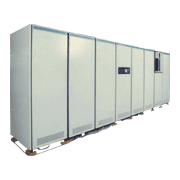This was the first Japanese produced 32-bit industrial computer designed for large-scale real-time online applications, and it was announced by Toshiba in 1978. It was designed throughout for ease-of-use and expandability based on Toshiba's wealth of experience in the control field, due to Toshiba's previous TOSBAC-7000 Series and TOSBAC-40 Series, and the series had the following features, which were based on a 32-bit architecture:
- (1)High-capacity, high-speed hardware which aimed to achieve powerful processing capability and high-speed response ・Main memory
- Logical space: 16 megabytes (Address space 24 bits)
- Maximum mountable: 1 megabyte ・Arithmetic speed
- Basic addition/subtraction: 0.36 microsecond
- DMA transfer: Max. 8 megabyte/sec
- (2)Outstanding expandability
- Peripheral equipments: Addressable up to 16x255 devices
- Achieved a composite system coupling a maximum of 8 machines via shared memory.
- (3)Enhanced system maintenance capability based on RAS (Reliability, Availability, Serviceability) design
- a. Expanded use of LSI
- b. Main memory ECC (error correction) and other detailed error detection
- c. Designed for improved maintainability, with features like online maintenance and remote diagnosis
- (4)Outstanding cost-performance due to a revolution in mounting technology, based on innovations such as large PC boards, mother boards and back panels
- (5)High-level languages, and highly expandable/flexible real-time software


